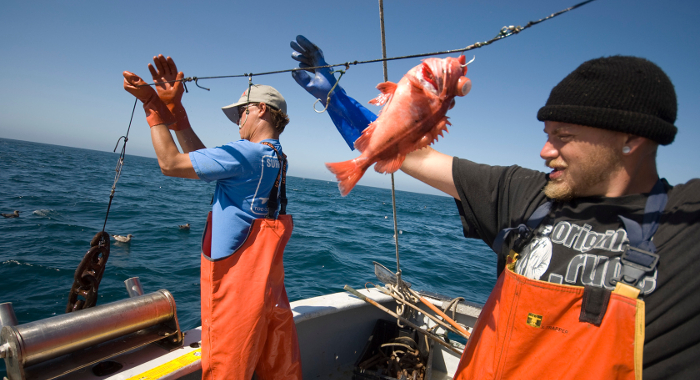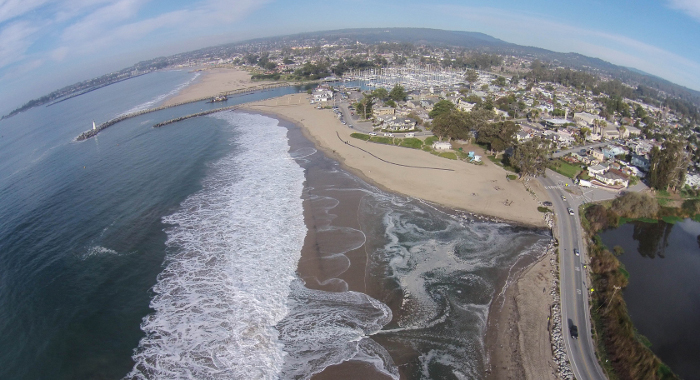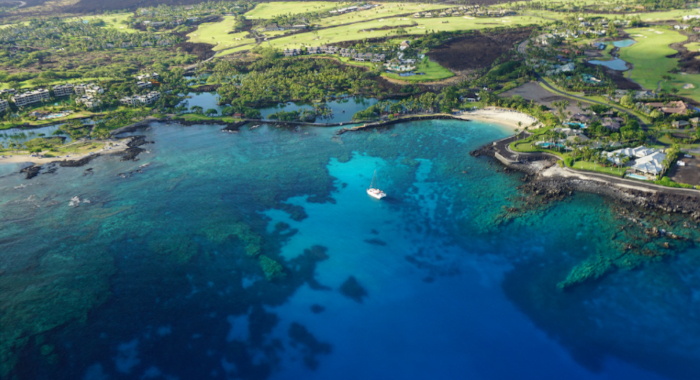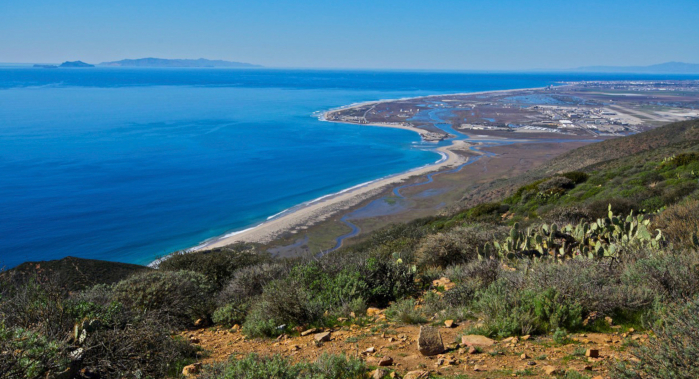The California Current is one of only four temperate upwelling systems in the world. Seasonal upwelling of nutrient-rich waters fuels a highly productive ecosystem, supporting biodiversity and fisheries that, along with coastal tourism, are a foundation of California’s economy.
Yet California’s coasts and oceans are also under increasing threat. Relatively few fisheries are managed based on robust scientific assessments, and more needs to be done to avoid overfishing and reduce bycatch. Plastics and other pollutants are pervasive. Climate change compounds these challenges. Ocean chemistry is changing. Sea levels and temperatures are rising – threatening important resources, biodiversity, and human populations.
Fortunately, the coastal and ocean ecosystems of California are bolstered by a network of marine protected areas and some of the most science-based marine policies in the world. Conservancy scientists look to build on those foundations by applying science and technology to enhance resilience of marine resources in the face of emerging threats.




Walter Heady, Alyssa Mann, Stacey Solie, Bob Battalio, James Jackson, Kendall Lousen, and Bob Barnes
The U.S. Congress and the Department of Defense (DoD) have determined that climate change is a threat to national security and have required military installations to develop plans to improve the…Alyssa Mann, Walter Heady, Charlotte Stanley
TNC and the United States Navy partnered together to prepare for the impacts of climate change on Naval Base Ventura County (NBVC), Point Mugu in California. NBVC is a critical and strategic asset of…Alyssa Mann, Walter Heady, Charlotte Stanley
Mary G. Gleason, Jennifer E. Caselle, Walter N. Heady, Vienna R. Saccomanno, Julie Zimmerman, Tristin Anoush McHugh, Norah Eddy
Global kelp forests are biodiverse and productive nearshore ecosystems that provide a wide range of ecosystem services, but they are at risk from both local stressors and global drivers of kelp loss.…Lyall Bellquist, Vienna Saccomanno, Brice X. Semmens, Mary Gleason, Jono Wilson
The health of ocean ecosystems is critical to maintaining natural biodiversity and sustainable fisheries, but federally-declared fishery disasters are reflecting devastating impacts to ecosystems,…Jono R Wilson, Darcy Bradley, Kristina Phipps, Mary G Gleason
Overfishing threatens the health and resilience of the ocean. In response, the global conservation community has set ambitious targets for protecting biodiversity inside no-take marine reserves. Yet…Serena Lomonico, Mary G Gleason, Jono R Wilson, Darcy Bradley, Kate Kauer, Richard J Bell, Thomas Dempsey
Climate change poses unprecedented challenges to the sustainable management of wild capture fisheries. Management systems that improve the flow of information so that actionable steps can be taken are…Eric Gilman, Michael Musyl, Petri Suuronen, Milani Chaloupka, Saeid Gorgin, Jono Wilson, Brandon Kuczenski
More than 4.5 million fishing vessels deploy fishing gear in the ocean every year. A significant amount of these nets, traps, lines, and floats are abandoned, lost, or discarded, threatening the…Andrew P. Nosal, Daniel P. Cartamil, Arnold J. Ammann, Lyall F. Bellquist, Noah J. Ben‐Aderet, Kayla M. Blincow, Echelle S. Burns, Eric D. Chapman, Ryan M. Freedman, A. Peter Klimley, Ryan K. Logan, Christopher G. Lowe, Brice X. Semmens, Connor F. White, Philip A. Hastings
Due to decades of heavy fishing pressure and steep population declines worldwide, the conservation status of the soupfin shark was elevated to Critically Endangered globally in 2020 by the…Jennifer Sletten, Mimi D’Iorio, Mary G. Gleason, Alex Driedger, Timoth´e Vincent, Claire Colegrove, Dawn Wright, Virgil Zetterlind
Understanding the complex seascape of regulations that apply across U.S. ocean waters is critical for effective marine resource management. This study found that cumulative restrictions from…Sydney J. Chamberlin, Michelle Passero, Ashley Conrad-Saydah, Tanushree Biswas, Charlotte K. Stanley
California’s natural and working lands – its forests, grasslands, wetlands, farmlands, rangeland, and urban green spaces – provide Californians with numerous environmental, social,…Aviv Karasov‐Olson, Alicia K. Bird, Amy C. Collins, Emily E. Graves, Julea A. Shaw, Eric F. Tymstra, T. Rodd Kelsey, Mark W. Schwartz
Conservation biology is particularly susceptible to the knowledge‐implementation gap where academic pursuits do not always meet the needs of practitioners. Providing future practitioners with…Bryan Legare, Bryan DeAngelis, Gregory Skomal
Broad-scale movements of highly migratory species, such as sharks, present unique management challenges as fish migrate across international boundaries, thereby exposing them to different levels of…Jonathan R. B. Fisher, Stephen A. Wood, Mark A. Bradford, Rodd Kelsey
Jonathan R. B. Fisher, Stephen A. Wood, Mark A. Bradford, Thomas Rodd Kelsey
Ray Hilborn, Ricardo Oscar Amoroso, Christopher M. Anderson, Julia K. Baum, Trevor A. Branch, Christopher Costello, Carryn L. de Moor, Abdelmalek Faraj, Daniel Hively, Olaf P. Jensen, Hiroyuki Kurota, L. Richard Little, Pamela Mace, Tim McClanahan, Michael C. Melnychuk, Cóilín Minto, Giacomo Chato Osio, Ana M. Parma, Maite Pons, Susana Segurado, Cody S. Szuwalski, Jono Wilson, Yimin Ye
Does fisheries management work at improving the status of fish stocks? The answer is a resounding, yes. This article compiles estimates of the status of global fish stocks, comprising roughly half of…Butterfield, H.S., M. Reynolds , M.G. Gleason, M. Merrifield, B.S. Cohen, W.N. Heady, D. Cameron, T. Rick, E. Inlander, M. Katkowski, L. Riege, J. Knapp, S. Gennet, G. Gorga, K. Lin, K. Easterday, B. Leahy, M. Bell
This Plan frames the biological and cultural significance and provides the short- and long-term goals, objectives, and priority actions for the Jack and Laura Dangermond Preserve.H.J. Walker Jr., Philip A. Hastings, John R. Hyde, Robert N. Lea, Owyn E. Snodgrass, Lyall F. Bellquist
In response to anomalously warm sea-surface temperatures, poleward shifts in the geographic range of hundreds of marine organisms worldwide have been documented. This paper reports on the unusual…